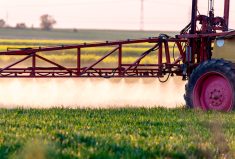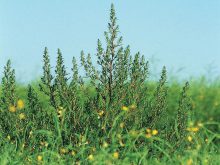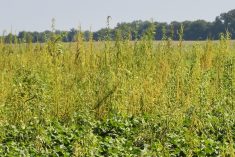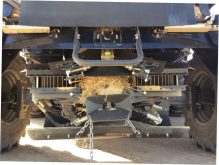Grain and oilseed growers making weekend plans are advised that herbicide-resistant weeds have way fewer places to hide right now.
Any weeds that lived through pre-seeding burnoff or post-emergent spraying — where other weeds have clearly died — are best caught early, the Canola Council of Canada said in a release Friday.
“It takes 14-21 days after a pre-seed glyphosate application for glyphosate-resistant kochia to become obvious, so keep an eye out while crossing over the farm while seeding or during in-crop herbicide applications,” council agronomy specialist Angela Brackenreed said.
Read Also

India slaps 30 per cent import duty on yellow peas
India has imposed a 30 per cent duty on yellow pea imports with a bill of lading date on or after Nov. 1, 2025.
The International Survey of Herbicide Resistant Weeds now documents 21 different weeds on Canada’s Prairies with herbicide resistance, mostly to Group 1 or Group 2 herbicides and in some cases to multiple groups, the council said.
As of February, there are 61 confirmed and unique cases of herbicide-resistant weeds across Canada, behind only the U.S. (150) and Australia (75), according to the ISHR.
Hugh Beckie, a research scientist with Agriculture and Agri-Food Canada in Saskatoon, estimated the number of acres on the Prairies with at least one resistant weed has gone from 10.9 million in the early 2000s to 38 million last year.
Beckie’s research also shows cleavers is one of the next most likely weeds to develop resistance to glyphosate (Group 9), the council said.
“Without management, these weeds will continue to spread and the effect on grower profits will only get worse,” Beckie said in the council’s release.
Growers also shouldn’t expect new herbicide modes of action to come along as they did 20 years ago, BASF rep Andrew Reid of Lacombe, Alta. said in a recent essay, noting the last such mode launched in the Prairie market was Group 27.
All that said, Brackenreed added, “we don’t want growers to throw up their hands and give up. This is a manageable situation.”
Growers, she said, should watch out for weed patches and any performance issues that raise suspicion, then mark those spots and use various tools to contain those patches “or, ideally, remove them entirely.”
The council urged a combination of early weed control, rotation of herbicide groups, crop rotation, tank mixes and pre-harvest or fall spraying where feasible.
The council also recommends closely following herbicides’ label directions on timing, specific controlled weeds and correct rates. Cutting rates, the council said, “may reduce herbicide efficacy and increase weed seed return to the soil seed bank.”
Brackenreed, who’s based at Minnedosa, Man., also recommended farmers follow integrated weed management (IWM) practices at seeding, such as higher seeding rates, shallow seeding depth and narrow row spacing among other tools to boost crop competitiveness.
“These techniques reduce the reliance on herbicides, which will actually improve results from herbicides and keep more herbicides working on the farm,” she said.
Tillage at pre-seed or post-harvest, to help manage emerged weeds or to encourage weed germination for winterkill or chemical control, is also an effective mechanical option if used properly, Reid said. Spot mowing, to prevent seed set, is another such option, the council added. — AGCanada.com Network












